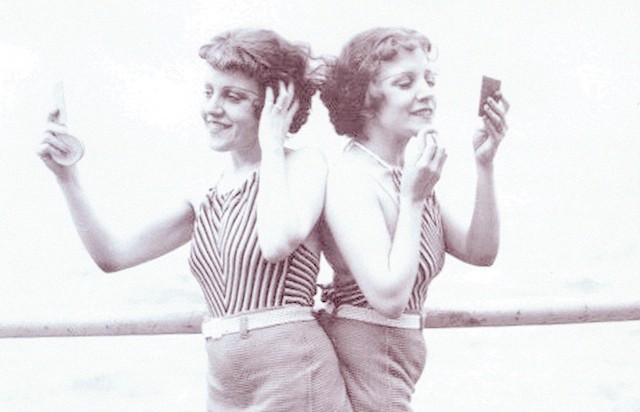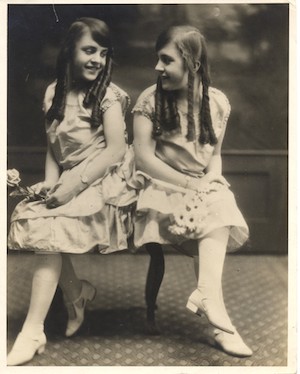Bonded and Bound by Flesh: The Story of Daisy and Violet Hilton
by Leslie Zemeckis

We all long for a kind of bond that can’t be broken by time or distance. You hear stories about twins who share a natural closeness and an almost telepathic communication when separated from the other. Who wouldn’t want a special connection with a sibling who was the mirror of our thoughts and feelings? Or would the attachment be so constricting it strangled? What if your special someone was inches from you 24/7, for life?
Daisy and Violet Hilton were sisters cemented together by a band of flesh. It was a curse and a blessing: without it, they would have been freed from their trouble; with it, they were the biggest celebrities of their time.
Born February 5, 1908 in Brighton, England, the two beautiful babies, attached back-to-back, were a horrifying spectacle to their unwed mother. She refused to feed and fondle them, and passed them off to the midwife, who looked at the twins and saw an opportunity staring back at her. She promptly adopted them, giving them her surname of Hilton, and plunked the pair on a rough hewn table in the back of her bar. For a couple pence, curiosity seekers could stare at the girls; some would even lift up their dresses and pinch the flesh that grew between them. Yes, they were legitimate freaks, their adopted mother — warden, really — would proclaim.
Soon they were on the road around Europe, the girls propped on display in fairs and carnivals. They would land in Australia and meet up with an even more vociferous guardian who would bring them increasing riches and fame, with a corresponding amount of suffering. The girls had limited contact with others, no understanding of money, and a limited education. Their persistent naivete left them constantly vulnerable to con men and unscrupulous promoters. The fortune they made — literal “bags of money” — would be stolen and spent by a trio of guardians.
One guardian, a former balloon salesman, had the bright idea to launch the girls on the vaudeville circuit, where no one had ever seen anyone like them. The girls were trained to sing, to dance, and to play musical instruments. They would end their act dancing with two handsome men: one time, they shared the stage with Bob Hope, just getting his start. The girls loved performing. It was their only sort of freedom in their lives, their only interaction with others.
Houdini became a fan and a mentor. Sold-out crowds came to see Daisy and Violet simply because they were conjoined. It was the Great Depression, and everyone had a cross to bear: the pretty girls made the audience’s burdens seem lighter. But of course, Daisy and Violet were earning much more.
The sisters had only themselves to rely on. Together, they endured whippings and threats. Their guardians slept in the same room as they did; they were never left alone, they were allowed no freedoms. Since birth, they’d been taunted with the prospect of experimentation: doctors wanted to cut them apart, but they wanted to remain as they were born. When the day came when they could have been separated, they said no: “We’ll be together always.”
Daisy and Violet shared a bed, a pregnancy brought to fruition, and even a lover. They fought for each other when it came time to challenge their guardian in court, and they broke the controlling legal bonds in place.

With freedom came the challenges of boyfriends. They sought mates, but not exclusive of the other. If a man took one sister, the other was always “inches away.”
Violet was the first to fall in love, but she was at first denied a lawful marriage. Judges in 21 states considered it “immoral.” It was Daisy who pleaded with the public to allow her sister the happiness she sought; it was also just another moment of heartbreak in a life full of them. For all their efforts, for all their wishes for the other, Daisy and VIolet struggled to lead normal lives.
When vaudeville died, they tried a stint in burlesque and eventually lost money in a horrid exploitation picture based on a sensationalized version of their lives. The Hilton Sisters would go on to try on all forms of early American entertainment, from sideshows to the stage to celluloid. There was a time when everyone in America knew who Daisy and Violet Hilton were.
As they aged, the girls grew desperate and were forced to make appearances at drive-in theaters. They fell prey to a series of managers who would abuse, cheat, and abandon them; they were left on the side of the road like old suitcases. Their time in show biz was over.
Somehow, they found their way to Charlotte, North Carolina, where southern hospitality did not let them down. They were offered a trailer home to stay in. They got jobs as grocery clerks at the popular Park-N-Shop on Wilkinson Boulevard. (“You only have to pay one of us,” they offered the owner.) And there, in the town nicknamed “The City of Churches,” they found friendship and protection to keep them there for the remainder of their lives.
What must it have been like at the end? They’d vowed to one another that when it was time, they would go together. In 1969, the Hong Kong flu swept through Charlotte indiscriminately, taking one, briefly sparing another. Daisy passed first. Violet died between two and four days later.
It’s been nearly 50 years since Daisy and Violet Hilton were buried in a donated cemetery plot. They share the same coffin, and the same headstone. It reads: “Daisy Violet Hilton.”
Leslie Zemeckis is the author of the book Behind the Burly Q, a history of burlesque, and an award-winning documentarian. Her latest film, Bound by Flesh premieres June 27 at select theatres around the country, VOD, and iTunes.